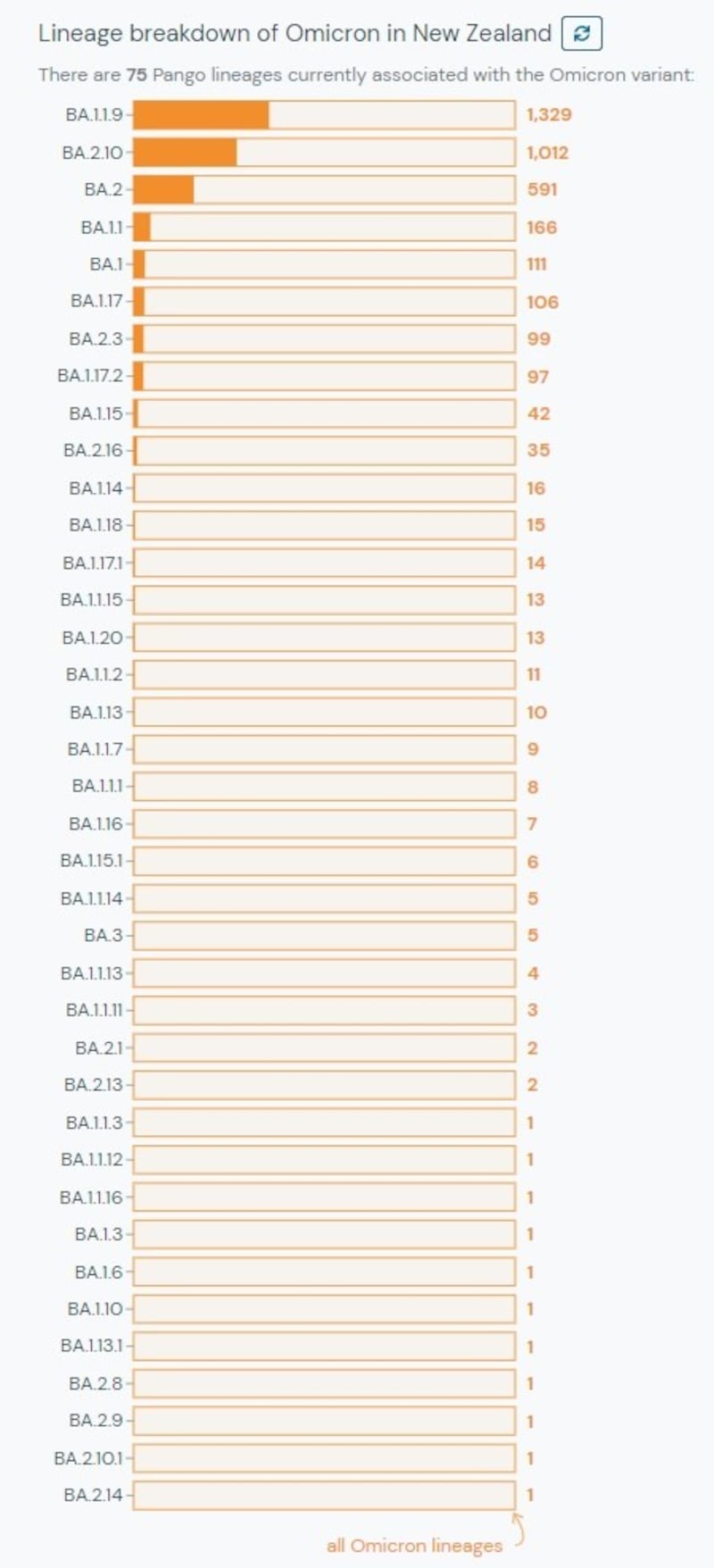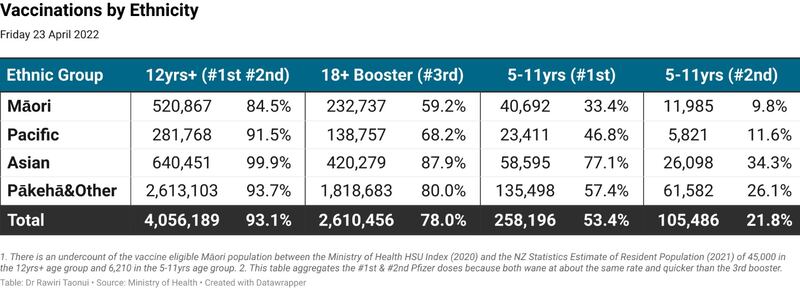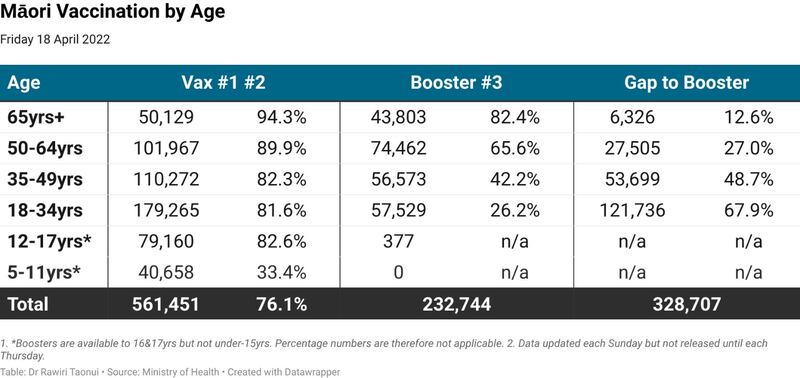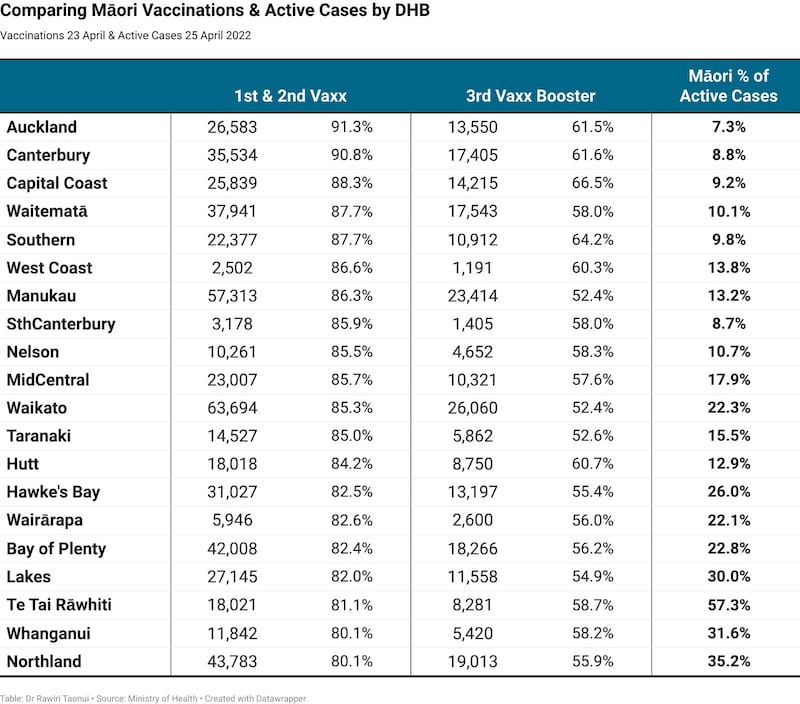A dramatic slowdown in five to 11-year-old tamariki and 18-49-year-old Māori vaccinations presents a considerable risk if a more severe variant targeting the young enters Aotearoa.
Omicron has been in steady decline. If we avert a second wave now numbers will decrease further over the next month. New variants and sub-variants have ready access through our more open borders.
Declining Māori vaccination uptake makes our communities vulnerable especially if a new variant targets younger people. While the current focus on economic recovery is important, it should proceed together with a focus on lifting Māori vaccination rates.
Omicron cases have steadily declined from a national peak of 29,000 cases on March 8. Omicron cases peaked in the three Auckland District Health Boards (DHBs) in early March. Other DHBs had peaked by the end of the first week of April.
New daily cases are following a distinct fluctuation between low testing and reporting on weekends and higher testing and reporting on weekdays. Lower Easter and ANZAC holiday case numbers reflect this pattern.
A moderate upsurge in numbers occurred in all DHBs after the country moved to the Orange Traffic Light setting on April 13. Much of the rise has come in Auckland, Christchurch, and Dunedin where post-Orange relaxation of cautionary behaviours such as mask-wearing and social distancing amid urban density have a greater impact.
Hospitalisations returned to over 500 yesterday and active cases have also risen from a low of 53,000 last week back to between 58,500 to 59,300. The number of deaths has decreased but the proportion outside Auckland is higher than last month. Sixteen of nineteen deaths in the last two days have been outside Auckland.
New cases have settled on a plateau with the seven-day average ranging between 7,500 and 9,700 for the past 14 days.
The plateau effect is also the result of a change in the balance of cases from the BA.1 subvariants of Omicron to the 30% to 50% more transmissible but not more lethal BA.2 sub-variants.
Māori cases
There were 644 and 714 new Māori cases over the past two days. The lowest figures since February 23, they end 49 consecutive days with Māori the second-highest cases.
The following map compares the overall total number of active cases, the total number of active Māori cases, and the percentage of active Māori cases in each DHB, between 18 April and 25 April.

Active Māori cases have fallen as a percentage of total active cases in 16 DHBs, most notably in the Lakes DHB from 37.6% to 30.0% and the Hutt DHB from 16.5% to 12.9%.
Second-wave risks
Driven by a relaxation in behaviours, waning immunity from vaccination and Omicron recoveries, many modellers are predicting a second wave at some time around July Others suggest the current plateau might precipitate a second wave sooner.
Opinion varies on waning immunity. The science is clear that those with boosters and recovery from Omicron will have strong protection from reinfection and/or severe disease for some months.
The World Health Organisation believes booster vaccinations will remain protective for up to six months. The US Centres for Disease Control and Prevention maintains that while stronger than two Pfizer vaccine doses, the third booster also begins to wane after four months.
The United States and Australia are recommending a fourth booster for those aged over 50yrs. There is no such move in New Zealand yet.
Border and new variant risks
The risk of a second wave has other contexts. With changes at our borders including self-recognisance testing and home isolation for entering vaccinated and unvaccinated New Zealanders, vaccinated Australians and shortly visa waiver countries our borders are more porous than at any other time during Covid-19.
The April 19 detection of the recombinant XE (BA.1 and BA.2) subvariant, which experts estimate to be 10% more transmissible than the BA.2 subvariant is a warning.
Omicron has mutated into more than 70 sub-variants. None is yet thought to cause more fatalities. However, if a new variant or subvariant emerges that impacts young people like the second wave of the Spanish Flu in 1918, then Māori would be dangerously exposed. By April 3, testing had detected 38 Omicron subvariants in New Zealand.


Since April 1, the nationwide uptake of first or second vaccinations in the 12yrs+ Māori group has dropped to an average of just 20 vaccinations per day nationwide. Notwithstanding, a 15% or thereabouts vaccine resistance, the numbers show a considerable refocus of previous energy and effort to close vaccination gaps to supporting whānau isolating at home over the last two months.
Uptake of a third booster shot is higher at an average of 177 per day since April 1. Nevertheless, the large 18.8% gap between the Māori and the national figure indicates the vulnerability of Māori should a more severe Covid variant enter Aotearoa’s permeable border.
If a new variant targets young people, the risk increases. There is a constant 20% gap between tamariki Māori and the national figure for five to 11-year-olds' first vaccinations. While a modest 161 per day uptake of the second vaccination demonstrates the vigilance of motivated whānau and parents, uptake of the first tamariki vaccination has slowed to 20 per day.
The risk is starker when breaking down age groups above 12 years of age. While just 12.6% of double vaccinated over-65yrs Māori have not received a booster, 50% of 35-49yrs Māori and an exceptionally large 67.9% of 18-34yrs Māori have not received boosters, our most valuable defence against Omicron and any new variants.

A similar pattern occurs in DHBs. The higher the double or boosted vaccination rate, the lower the percentage of active Māori cases. The lower the double and boosted vaccination rate, the higher the percentage of Māori active cases in each DHB.

Kia noho haumaru, stay safe and self-sovereign.
Dr Rawiri Taonui



